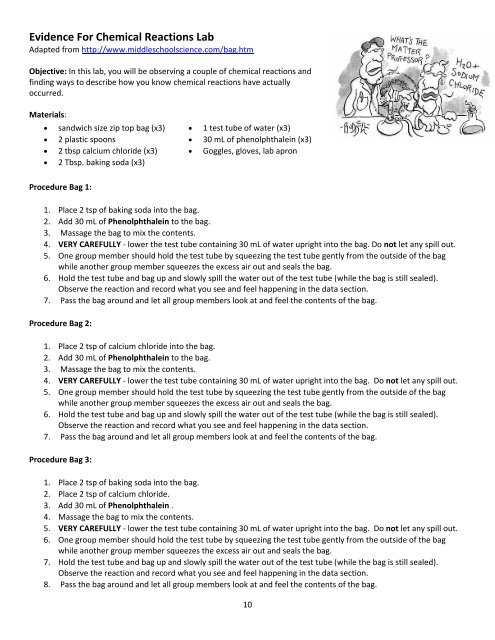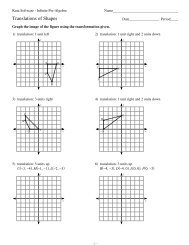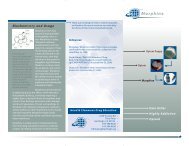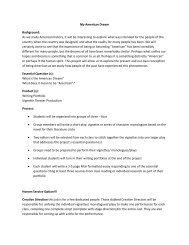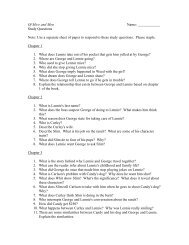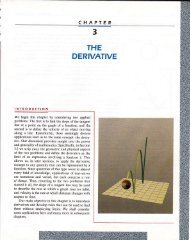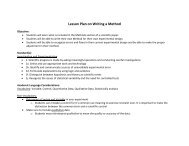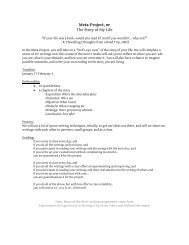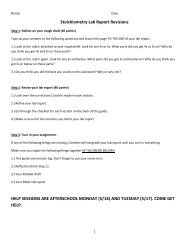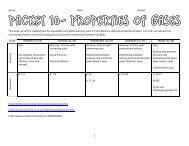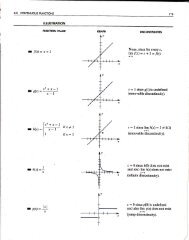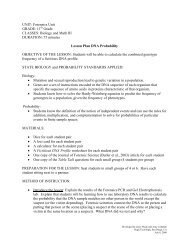1 Name: Date: Period: Project Description: In this project, you will be ...
1 Name: Date: Period: Project Description: In this project, you will be ...
1 Name: Date: Period: Project Description: In this project, you will be ...
You also want an ePaper? Increase the reach of your titles
YUMPU automatically turns print PDFs into web optimized ePapers that Google loves.
Evidence For Chemical Reactions LabAdapted from http://www.middleschoolscience.com/bag.htmObjective: <strong>In</strong> <strong>this</strong> lab, <strong>you</strong> <strong>will</strong> <strong>be</strong> observing a couple of chemical reactions andfinding ways to descri<strong>be</strong> how <strong>you</strong> know chemical reactions have actuallyoccurred.Materials: sandwich size zip top bag (x3) 2 plastic spoons 2 tbsp calcium chloride (x3) 2 Tbsp. baking soda (x3)1 test tu<strong>be</strong> of water (x3)30 mL of phenolphthalein (x3)Goggles, gloves, lab apronProcedure Bag 1:1. Place 2 tsp of baking soda into the bag.2. Add 30 mL of Phenolphthalein to the bag.3. Massage the bag to mix the contents.4. VERY CAREFULLY - lower the test tu<strong>be</strong> containing 30 mL of water upright into the bag. Do not let any spill out.5. One group mem<strong>be</strong>r should hold the test tu<strong>be</strong> by squeezing the test tu<strong>be</strong> gently from the outside of the bagwhile another group mem<strong>be</strong>r squeezes the excess air out and seals the bag.6. Hold the test tu<strong>be</strong> and bag up and slowly spill the water out of the test tu<strong>be</strong> (while the bag is still sealed).Observe the reaction and record what <strong>you</strong> see and feel happening in the data section.7. Pass the bag around and let all group mem<strong>be</strong>rs look at and feel the contents of the bag.Procedure Bag 2:1. Place 2 tsp of calcium chloride into the bag.2. Add 30 mL of Phenolphthalein to the bag.3. Massage the bag to mix the contents.4. VERY CAREFULLY - lower the test tu<strong>be</strong> containing 30 mL of water upright into the bag. Do not let any spill out.5. One group mem<strong>be</strong>r should hold the test tu<strong>be</strong> by squeezing the test tu<strong>be</strong> gently from the outside of the bagwhile another group mem<strong>be</strong>r squeezes the excess air out and seals the bag.6. Hold the test tu<strong>be</strong> and bag up and slowly spill the water out of the test tu<strong>be</strong> (while the bag is still sealed).Observe the reaction and record what <strong>you</strong> see and feel happening in the data section.7. Pass the bag around and let all group mem<strong>be</strong>rs look at and feel the contents of the bag.Procedure Bag 3:1. Place 2 tsp of baking soda into the bag.2. Place 2 tsp of calcium chloride.3. Add 30 mL of Phenolphthalein .4. Massage the bag to mix the contents.5. VERY CAREFULLY - lower the test tu<strong>be</strong> containing 30 mL of water upright into the bag. Do not let any spill out.6. One group mem<strong>be</strong>r should hold the test tu<strong>be</strong> by squeezing the test tu<strong>be</strong> gently from the outside of the bagwhile another group mem<strong>be</strong>r squeezes the excess air out and seals the bag.7. Hold the test tu<strong>be</strong> and bag up and slowly spill the water out of the test tu<strong>be</strong> (while the bag is still sealed).Observe the reaction and record what <strong>you</strong> see and feel happening in the data section.8. Pass the bag around and let all group mem<strong>be</strong>rs look at and feel the contents of the bag.10


